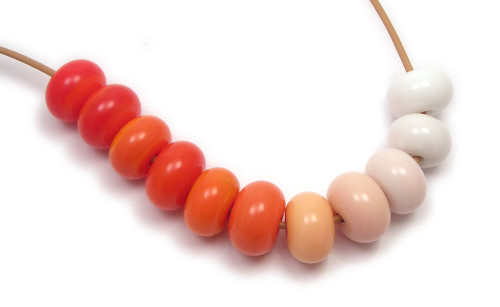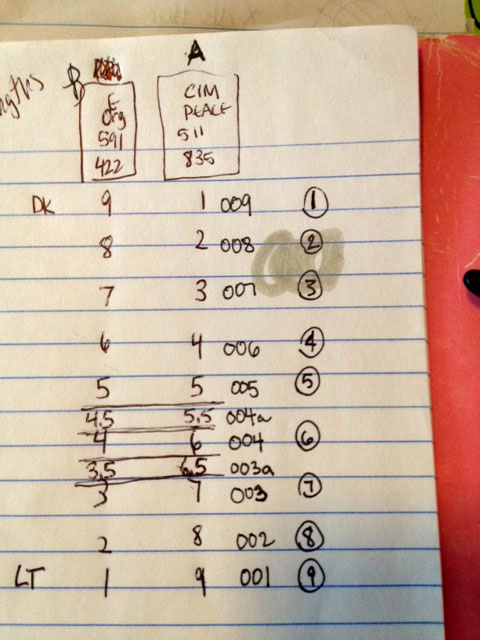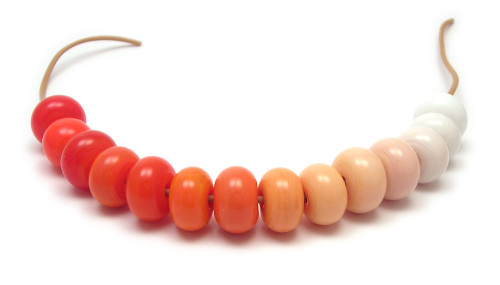I started in on the color mixing. As expected it is very time consuming and relaxing if I’m not thinking about all of the other things I could/should be doing. I justified ‘wasting time’ by the fact that I worked my butt off the first half of the days in my ISGB volunteer board member role.

I set out in my experiments to do a gradation of color starting with 1 part color A and 9 parts color B, for a total of 10 parts. On to 2 parts color A, 8 parts color B and so on. Knowing full well in advance that at some point, with a very saturated strong color, that the colors will look the same. Regardless, I am going through the exercise and mixing all 9 colors because at some point, I might want to choose color number 7 in the string, as opposed to color number 8 that might look exactly the same, and mix those down another spectrum or down to white. In that case, I think the difference will show up. I’m just guessing there though.
Above is a photo of the 9 mixes with a bead on either end made from the color straight off the rod. CIM Peace and Effetre Orange 422. I have many variations of white and I am guessing that they will all give different effects in the mixing. I consider CIM Peace to be more stable than the four Effetre and Vetrofond ‘whites’ I have.
There are so many things to take into consideration and unlike Dietmar’s mixes, I am not taking as scientific an approach. I am not weighing my color to make sure it is exact. My rods may be different thickness or a mm longer in length when I cut. I will try to be as close as I can in that process.
While this strand looks the same as the one above, there are a few beads added. From the initial 9 mixes I chose where I thought there was the biggest jump in color and mixed color to fill in. Such as, 6.5 parts color A and 3.5 parts color B. This makes the transition more smooth but I can already see jumps where I want even more subtlety. One is between bead 3 and 4 (from the right) and again between 7 and 8.
Interestingly, after bead number 8, things seem to go a bit haywire. I attribute this to the larger concentration of the orange and the fact that orange strikes and changes in the flame, the more you work it.
At the left side of the above strand there are two beads made with color right from the rod. They are different from each other. Maybe I should have started with blue.
I have a dilemma with how to document and number the colors. I get pretty picky when doing this but it pays off to have it set up well in the beginning so this will take much more thought and rearranging. This is what my naming table looks like so far:
 The circled nubmers represent the first 9 mixes and correspond to the three digit number to the left. The numbers with “a” after them are those mixes inbetween. Those three digit with “a”, “b” etc after them will be the last digits of the number. I am thinking of using the three digit manufacturer numbers for each color so say, the bead between 6 and 7 would be: 422835003a.
The circled nubmers represent the first 9 mixes and correspond to the three digit number to the left. The numbers with “a” after them are those mixes inbetween. Those three digit with “a”, “b” etc after them will be the last digits of the number. I am thinking of using the three digit manufacturer numbers for each color so say, the bead between 6 and 7 would be: 422835003a.
I know that looks crazy but I’ve come up with numbering methods like that for my photos and documents on my computer and believe me, it works and is easy to decipher if you know the formula. Now, can I fit that onto the bead with a glass pen? And, how do I know that that is Effetre 422 and not Vetrofond? (although Vetrofond is going out of business).
Lots to consider and it is important to keep a good notebook (and blog posts like this) for future reference of challenges, decisions, directions I go, etc).
So, dig it? Or, damn-that-put-me-to-sleep-you-crazy-person?

